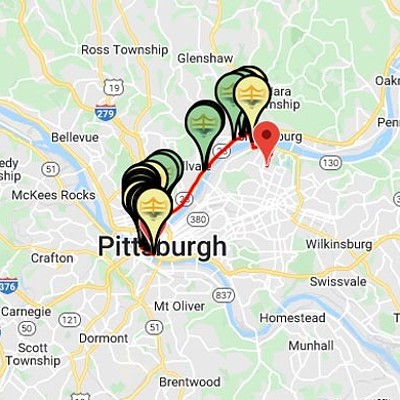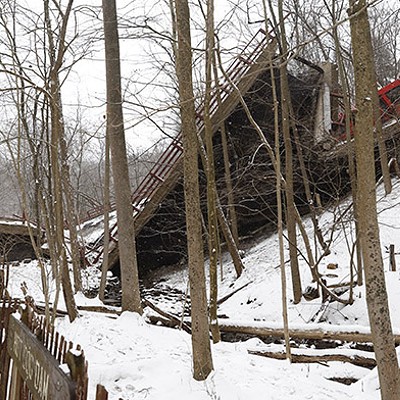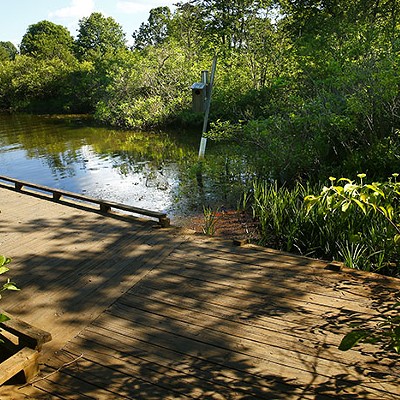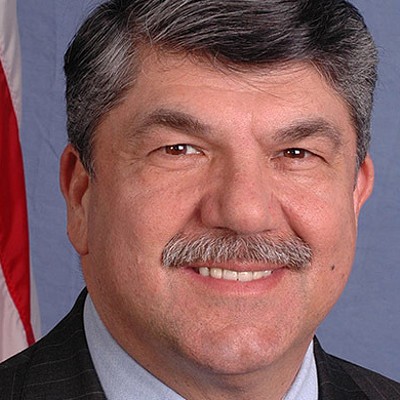
The proposed extension of the Mon-Fayette Expressway is the highway plan that just won’t die. The raised, four-lane express toll-road from Jefferson Hills through Duquesne to Monroeville has been started and stalled so many times since the idea was first dreamed up in the late 1950s, that some have nicknamed it the “zombie highway.”
Sustainable-development nonprofit PennFuture has campaigned against the Mon-Fayette for years and gave it the undead moniker in 2015. “It is the zombie highway because you can’t kill it,” says Andrea Boykowycz, formerly of PennFuture. “It’s impossible to kill.”
But there’s a reason the Mon-Fayette won’t stay buried: It’s been embedded into the Mon Valley’s hopes and dreams for decades. The highway was first proposed as a way to increase productivity of the steel and industrial facilities that hummed along the Monongahela River in the 1950s, but it was scrapped due to lack of funding. It was proposed again in the mid-1980s to help revitalize the Mon Valley, which had seen massive decline with the collapse of Pittsburgh’s steel industry, but funding remained an issue.
Since then, every several years, the Mon-Fayette gets floated as the big idea to help revitalize the Mon Valley, which suffers from some of the worst unemployment in the Pittsburgh region. But critics recognize the highway’s serious issues, like its high price tag and the lengthy completion timeline. Additionally, the project never actually materializes.
“It’s almost a meaningless promise, but it also serves as gospel,” says Boykowycz.
Regardless, a powerful group of state politicians and business leaders believes the Mon-Fayette is still the answer. However, critics, including town supervisors and activists, say the Mon Valley should instead make improvements to existing infrastructure with Complete Streets policies — where road design equally accommodates drivers, pedestrians, public transit and cyclists — believing that will spur economic development.
Whether the Mon-Fayette could revive the Mon-Valley economy or not is up for debate, but it appears the discussion isn’t fading away anytime soon.
The Pennsylvania Turnpike Commission, which is tasked with designing and constructing the Mon-Fayette, says funding will come from the state tax that drivers pay for gasoline, and the group is in process of renewing the Mon-Fayette’s approval with Southwestern Pennsylvania Commission, a transportation and development-planning agency. The Turnpike Commission currently projects a $2.1 billion price-tag for the 14-mile highway connecting two suburban municipalities.
According to Turnpike Commission spokesperson Carl DeFebo, the highway extension should receive 37,000 vehicles a day in 2045. DeFebo says current designs show the commission will need to acquire land on 689 properties, including 237 residences, to complete construction of the Mon-Fayette. A toll amount hasn’t been finalized for the Mon-Fayette, but DeFebo says it will be comparable to other Turnpike extensions in the region, like the Beaver Valley Expressway. (These cashless tolls require drivers to have an E-Z Pass.)
DeFebo says that the commission is merely the facilitator of the project, not its advocate. “The [Turnpike Commission] was directed to advance this project as well as other projects by the [state] Legislature,” wrote DeFebo in an email to Pittsburgh City Paper. “Our role is not to advocate the expressway, but to design and construct it.”
Projects like the Mon-Fayette were given to the Turnpike Commission in 1986 thanks to the passage of state Act 61, which authorized the commission to undertake a program of capital improvements and construction projects. State Sen. Jim Brewster (D-McKeesport) still very much supports the Mon-Fayette, says his chief of staff Tim Joyce, citing its economic development potential.
“It opens up different opportunities,” says Joyce. “Businesses have always looked for the shortest roots to deliver their products, and a modern highway improves those options.”
Joyce points out old brownfield sites in Clairton, McKeesport and Duquesne as potential beneficiaries of the highway, even though the proposed Mon-Fayette route doesn’t directly connect to many of those sites.
“It’s close enough that the surrounding communities will take notice and benefit,” says Joyce. He adds that just because the highway is built doesn’t mean towns can’t also focus on streetscape improvements and redesigns.
However, history shows that large, raised expressways can have a negative effect on neighborhoods. According to a March 2016 Washington Post article, former U.S. Department of Transportation Secretary Anthony Foxx, who grew up in a Charlotte neighborhood bisected by expressways, advocated for removing expressways in Miami, Los Angeles, New York City, Seattle and Baltimore because they sliced through and hurt neighborhoods. “It became clear to me only later on, that those freeways were there to carry people through my neighborhood, but never to my neighborhood,” said Foxx in the Post. “Businesses didn’t invest there. Grocery stores and pharmacies didn’t take the risk.” (Local politicians have cited similar effects from I-279 in the North Side.)
PennFuture CEO Larry Schweiger still believes the Mon-Fayette will hurt the Mon Valley, and will take away potential funds to help repair some of the state’s deteriorating roads and bridges. According to the U.S. Department of Transportation, Pennsylvania has the second-highest number of structurally deficient bridges (9,561) among the 50 states, and 57 percent of its roads are in mediocre or poor condition.
“The Mon/Fayette Expressway is an extremely expensive pork-barrel project that will rip apart communities to provide access to a sparsely populated part of the state,” wrote Schweiger in a statement to CP. “This boondoggle will saddle the motoring public statewide with the bill when … fuel taxes could be better served repairing failing bridges and crumbling roadways. Let’s fix the problems that we have before building more highways.”
But Mon-Yough Area Chamber of Commerce director Maury Burgwin feels the Mon-Fayette must come first to revitalize development in the region. His business organization covers most of the area the Mon-Fayette would serve, and he says a modern highway would attract industrial developers to the almost 1,000 acres of “shovel-ready” plots in the region.
“If you are going to put in some serious development on those sites, you need to develop those roads,” says Burgwin. “The trucking industry is growing.”
Burgwin added that Kennywood has expressed interest in expanding if the road were completed. The Turnpike Commission’s projections forecast the creation of 5,700 private-sector jobs, 19,500 jobs in relation to building the highway, and $3.86 billion in total economic impact.
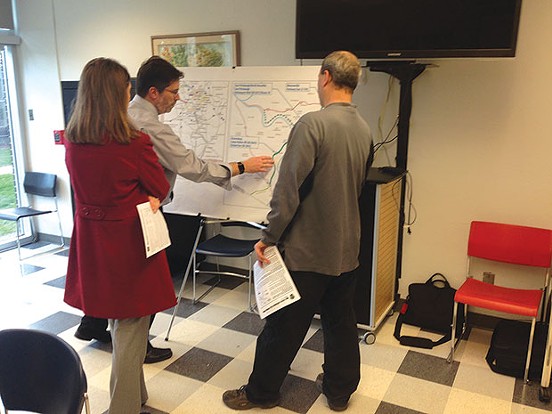
Burgwin says some developers have been intrigued by industrial sites in McKeesport, but no one has committed. He believes building out the road is necessary to attract business. But there is a long time to wait. According to the Turnpike Commission’s projections, the road wouldn’t be complete until 2036.
For Turtle Creek Mayor Kelley Kelley, this lengthy build-time will only perpetuate the decades-long promise to Mon-Valley residents. Although her town’s government has not officially come out against the project, Kelley is opposed because the road will cut through Turtle Creek’s business district; it would displace some long-time residents, and she fears the area will become a bypassed borough.
“We will simply be the town that everyone drives over,” wrote Kelley in an email to CP. “I personally feel that the threat of the expressway being built (going on 30 some years now) has actually discouraged people from moving businesses into our area, or redeveloping other parts. Why come into a town and buy or rent space that is scheduled to be demolished and not replaced?”
Turtle Creek isn’t the only town fearing a negative impact of the Mon-Fayette. Mike Boyd is a town supervisor from Wilkins Township. Wilkins supervisors recently voted 5-0 on a resolution against the Mon-Fayette.
“From the perspective of residents in Wilkins, the Mon-Fayette expressway will not add a lot of useful connectivity,” says Boyd. “We need access to the city of Pittsburgh.”
Originally, a segment was planned to connect Turtle Creek to Oakland. That plan was scrapped in 2015, due to high costs and opposition from the community. (Ironically, an area that would have been served by the canceled leg of highway, Almono in Hazelwood, is now seeing development commitments from Uber and Carnegie Mellon University, and will be Pittsburgh’s first Complete Streets-designed development.)
Boyd would like to see a commitment to alternative transit in the Mon Valley to facilitate people visiting areas like Wilkins. (Turnpike officials have floated the idea of connecting the East Busway to Turtle Creek, and then allowing buses on the Mon-Fayette, but Port Authority would have to build the busway extension and its capital funds are limited.)
And Molly Nichols, of public-transit advocacy group Pittsburghers for Public Transportation, agrees with Boyd and believes addressing current transit needs are better than the “if we build it they will come” mentality of Brewster and Burqwin.
“Our region should not spend over $2 billion on a highway, especially when there is a lack of clear evidence that we need it,” says Nichols. “There is no question we need more public transit and Complete Streets infrastructure in the Mon Valley.”
Boyd sees the Mon-Fayette as counter to Wilkins’ current bike and pedestrian friendliness since the highway would eliminate Thompson Run Road, a popular road for biking and jogging. Boyd also worries that the Mon-Fayette will increase traffic, noise and pollution in Wilkins, which sits nestled in a valley, and he can’t imagine his residents using the road, since it will only be accessible via cashless toll.
“There is necessity for better connectivity in the Mon Valley,” says Boyd, “but we should make improvements to the state roads, and make minor modifications to improve flow and accessibility. A giant toll road connecting two semi-outer communities doesn’t answer our region’s needs. We need a more holistic approach, rather than this one-off approach.”
Not all town leaders are opposed. Duquesne Mayor Phil Krivacek told WPXI in August 2016 that the expressway will exceed expectations. “It’s about the economy and building the economy. And that’s what I’m hoping for. It brings it back, so we don’t have to struggle,” Krivacek told WPXI. Fifteen towns also passed resolutions supporting the Mon-Fayette in 2014. But Boykowycz, formerly of PennFuture, is quick to point out that those resolutions passed before the Turnpike Commission eliminated the connection to Pittsburgh, which provided an alternate route around the traffic-heavy Squirrel Hill Tunnel.
Boykowycz worries the highway will just encourage sprawl that creates suburban bedroom communities, instead of spurring business growth in the Mon Valley. She believes those billions could go a long way to redeveloping Mon Valley towns with road and sidewalk improvements that modernize business districts. Boykowycz says this is the way to attract new small businesses and young residents looking for a walkable community, citing Millvale’s recent success in revitalizing its business district.
“It’s a complete and utter waste of money,” she says. “It’s not furthering or supporting a vision. It’s not congruent with current transportation priorities.”
Ultimately, however, critics’ opinions of the Mon-Fayette only matter if they are able to sway the Mon Valley’s state legislators. Boykowycz says the only way to kill the Mon-Fayette is for the state legislators to pass a bill rewriting Act 61. She says that trying to outflank the Mon Valley representatives, almost all of whom are Democrats, by garnering Republican support is unlikely because legislators don’t tend to vote to remove projects from other legislators’ districts. This means Brewster and the Mon Valley state House reps would have to denounce the Mon-Fayette. But because the Mon-Fayette has become over the decades such a powerful symbol of revitalization, Boykowycz says it’s extremely rare for a state legislator in the area to campaign against it.
But the zombie highway isn’t fully revived yet. The Southwestern Pennsylvania Commission still has to approve placing the project on its Transportation Improvement Program, which helps the project comply with federal guidelines. Public comments are accepted for the Mon-Fayette until March 10 and can be sent to [email protected].


